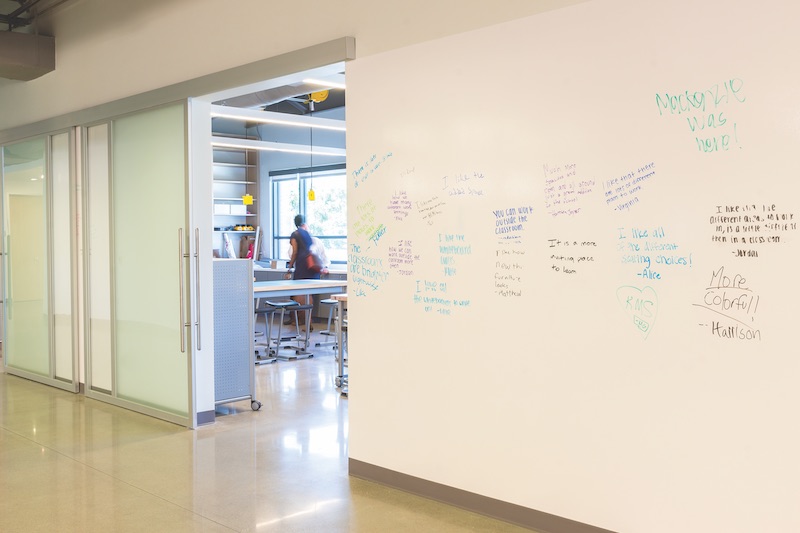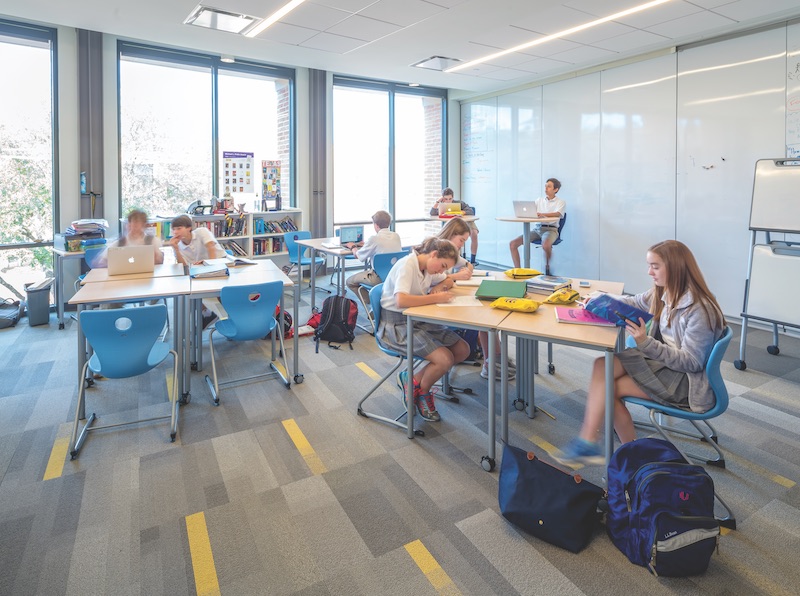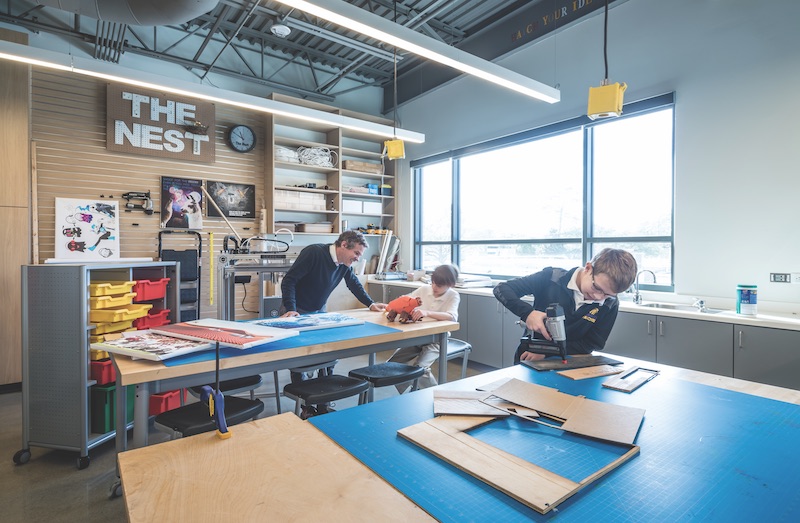Can you read the writing on the wall? At the new Kinkaid Learning Center, in Houston, that question can be taken figuratively and literally.
Thanks to dry-erase walls that line the learning center’s maker spaces, reading the writing on the wall becomes just another step in the creation process.
Designed by Kirksey Architecture’s PK-12 Education Team, the learning center’s maker spaces are meant to create a flexible learning environment that veers somewhat from traditional teaching methods.
Included in the new 26,000-sf building are crafting spaces, sewing spaces, a custom laser printer, a 3D printing space, and transportable “pop-up” maker spaces that can easily be moved from one classroom to another.
Dry-erase walls located between two classrooms have the ability to slide apart to create one large classroom for co-teaching. A literature teacher teaching Kurt Vonnegut’s Cat’s Cradle could combine with a history teacher teaching about the nuclear arms race.
 Courtesy Kirksey.
Courtesy Kirksey.
These maker spaces are meant to fight back against the “sage on the stage” concept of teaching. Kinkaid students can take an active, hands-on approach to their education.
This hands-on approach was integrated into the design process of the learning center, as well. Students and teachers took part in a visionary workshop, where they were asked to create an ideal environment for the new center and classrooms. Kirksey then integrated these suggestions into the final design.
The Nest is a workshop maker space equipped with the tools and materials necessary for building. New middle school classrooms use bright colors and floor-to-ceiling windows to allow for abundant natural light.
 Courtesy Kirksey.
Courtesy Kirksey.
The furniture in these classrooms is easily movable to encourage student interaction. The idea of flexible, movable furniture was carried throughout the entire learning center to allow students to study and collaborate as effectively as possible.
The Kinkaid Learning Center just completed its first academic year after opening in time for the 2016 school year.
Related Stories
75 Top Building Products | Apr 22, 2024
Enter today! BD+C's 75 Top Building Products for 2024
BD+C editors are now accepting submissions for the annual 75 Top Building Products awards. The winners will be featured in the November/December 2024 issue of Building Design+Construction.
AEC Tech | Feb 20, 2024
AI for construction: What kind of tool can artificial intelligence become for AEC teams?
Avoiding the hype and gathering good data are half the battle toward making artificial intelligence tools useful for performing design, operational, and jobsite tasks.
Sustainability | Nov 1, 2023
Researchers create building air leakage detection system using a camera in real time
Researchers at the U.S. Department of Energy’s Oak Ridge National Laboratory have developed a system that uses a camera to detect air leakage from buildings in real time.
Resiliency | Aug 7, 2023
Creative ways cities are seeking to beat urban heat gain
As temperatures in many areas hit record highs this summer, cities around the world are turning to creative solutions to cope with the heat. Here are several creative ways cities are seeking to beat urban heat gain.
AEC Innovators | Jun 15, 2023
Rogers-O'Brien Construction pilots wearables to reduce heat-related injuries on jobsites
Rogers-O'Brien Construction (RO) has launched a pilot program utilizing SafeGuard, a safety-as-a-service platform for real-time health and safety risk assessment. Non-invasive wearables connected to SafeGuard continuously monitor personnel to prevent heat exhaustion on jobsites, reducing the risk of related injuries. RO is the first general contractor to pilot this program.
Office Buildings | May 15, 2023
Sixteen-story office tower will use 40% less energy than an average NYC office building
This month marks the completion of a new 16-story office tower that is being promoted as New York City’s most sustainable office structure. That boast is backed by an innovative HVAC system that features geothermal wells, dedicated outdoor air system (DOAS) units, radiant heating and cooling, and a sophisticated control system to ensure that the elements work optimally together.
Design Innovation Report | Apr 27, 2023
BD+C's 2023 Design Innovation Report
Building Design+Construction’s Design Innovation Report presents projects, spaces, and initiatives—and the AEC professionals behind them—that push the boundaries of building design. This year, we feature four novel projects and one building science innovation.
Design Innovation Report | Apr 19, 2023
Reinforced concrete walls and fins stiffen and shade the National Bank of Kuwait skyscraper
When the National Bank of Kuwait first conceived its new headquarters more than a decade ago, it wanted to make a statement about passive design with a soaring tower that could withstand the extreme heat of Kuwait City, the country’s desert capital.
Design Innovation Report | Apr 19, 2023
HDR uses artificial intelligence tools to help design a vital health clinic in India
Architects from HDR worked pro bono with iKure, a technology-centric healthcare provider, to build a healthcare clinic in rural India.
3D Printing | Apr 11, 2023
University of Michigan’s DART Laboratory unveils Shell Wall—a concrete wall that’s lightweight and freeform 3D printed
The University of Michigan’s DART Laboratory has unveiled a new product called Shell Wall—which the organization describes as the first lightweight, freeform 3D printed and structurally reinforced concrete wall. The innovative product leverages DART Laboratory’s research and development on the use of 3D-printing technology to build structures that require less concrete.

















